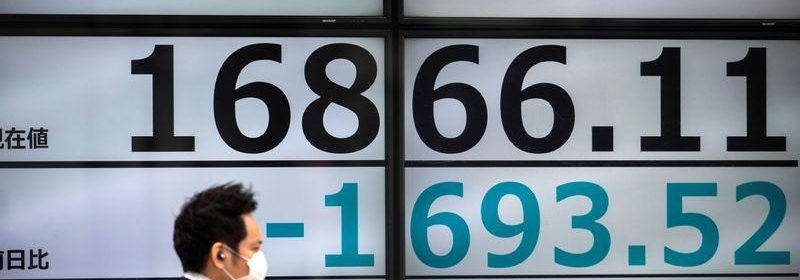Global stocks recover on firmer futures, retreat in U.S. yields

LONDON/SYDNEY (Reuters) – Global stocks steadied on Tuesday, supported by stronger U.S. equity futures and a decline in U.S. and European bond yields.
In Europe, the Euro STOXX 600 was up 0.1% after a gains on Monday that lifted Germany’s index to a record high.
In volatile trading in Asia, the Shanghai Composite index fell 1.8% and was close to a correction from a multi-year high on Feb. 18 amid fears of policy tightening. Japan’s Nikkei finished 1% higher as consumer goods companies and property developers gained on expectations they would benefit from an economic recovery.
“We’re going through a consolidation phase,” said Francois Savary, chief investment officer at Prime Partners. “There is a trend towards a rotation in the market, which is correct as price-to-earnings ratios were excessive. But overall, we think we will have a more balanced equity market than 2020, though volatility is going to stay with us.”
NASDAQ futures rose 1.6% and S&P 500 futures 0.8%.
U.S. Treasury Secretary Janet Yellen said on Monday that President Joe Biden’s coronavirus aid package would provide enough resources to fuel a “very strong” U.S. economic recovery, and noted “there are tools” to deal with inflation.
Still, investors remain conflicted over whether the stimulus will help global growth rebound faster from the COVID-19 downturn or cause the world’s biggest economy to overheat and fuel inflation.
“The chance of our seeing more inflation in the economy is meaningfully increased by the monetary policy actions and the fiscal policy actions that we’re seeing around the world,” Goldman Sachs Chief Executive Officer David Solomon told a conference in Sydney via webcast.
“There is certainly a reasonable outcome where inflation accelerates more quickly than people are expecting, and that will obviously have an impact on markets and volatility.”
The technology sector and other richly valued companies have been highly susceptible to the rising rates.
Australian shares tracked overnight gains on Wall Street with the main S&P/ASX 200 index climbing 0.5% on Tuesday. However, Australian tech stocks slid for the sixth straight session, in line with their U.S. peers.
Similarly, South Korea’s KOSPI fell 0.7%, dipping for a fourth straight session, as tech shares sold off.
U.S. economic data pointed to a continued recovery. Wholesale inventories increased in January despite a surge in sales, the Commerce Department said on Monday, suggesting inventory investment could again contribute to growth in the first quarter.
“If rates are grinding higher because people are getting optimistic about what economic growth looks like, that is still supportive for equity prices,” said Tom Hainlin, global investment strategist at U.S. Bank Wealth Management’s Ascent Private Wealth Group in Minneapolis.
Long-dated euro zone government bond yields dipped ahead of the release at 1000 GMT of final gross domestic data for the bloc. A Reuters poll forecast the region’s economy contracted 5% from a year before.
Germany’s 10-year government bond yield dropped two basis points to -0.298%.
U.S. 10-year Treasury bond yields also eased, to 1.5472%. Treasury yields have been advancing in recent months as investors price in higher inflation and more upbeat prospects for the U.S. economy.
In foreign exchange markets, the dollar index backed away from a three-and-a-half-month high. In signs risk appetite is returning, sterling, the Aussie, and the Kiwi dollar all edged up. The euro was up 0.1% at $1.185.
Oil prices fell on Tuesday, on receding fears of a supply disruption in Saudi Arabia after an attack on its export facilities.
Brent crude futures for May fell by 0.7% to $67.78 a barrel. U.S. West Texas Intermediate (WTI) crude for April slipped by 0.8% to $65.53.
Spot gold added 0.7% to $1,692.21 an ounce.
Source: Read Full Article
